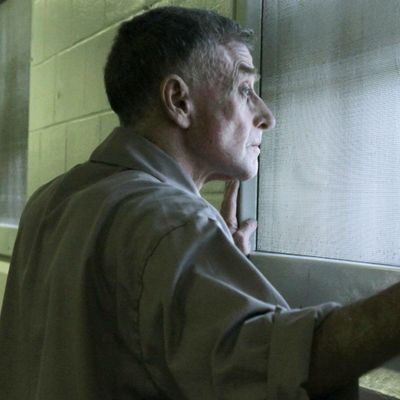
Who killed Kathleen Peterson? As documented by the true-crime series The Staircase — a 13-part investigation that follows the murder trial of her husband, Michael Peterson — neither the prosecution nor the defense told a story that seemed to make perfect sense. Durham County district attorney James Hardin Jr. contended that Michael had beaten Kathleen to death with a fireplace tool known as a blow poke, but defense experts claimed the blood-spatter patterns didn’t match that scenario, and the supposed murder weapon was eventually found and essentially ruled out. Meanwhile, Peterson and his attorney posited that Kathleen simply had a terrible fall down the stairs, but that didn’t sound right either: The lacerations on her head seemed too severe and the amount of blood just too great.
But a third theory, which sounds ridiculous at first, might actually make more sense than either of those presented at trial: Did an owl attack ultimately led to Kathleen Peterson’s death? “An owl did it!” reads like breathless straw-grasping from a defense team with nothing left to lose, but that wasn’t the case — the defense never once brought it up in court. The “owl theory,” as it’s known to those following the case, originated with a lawyer named Larry Pollard, who happened to be the Petersons’ next-door neighbor. And he didn’t come up with it until the months-long trial was nearly over.
Here’s the short version of the owl theory: Kathleen was heading back into the Petersons’ house when an owl silently swooped down and struck her head, digging its talons deep into her scalp. She moved inside to escape the bird, leaving a bit of blood outside. She had been drinking, and there were muscle relaxers and anti-anxiety medication in her system. Woozy and scared, she headed upstairs, presumably to tend to her wounds, and slipped, fell backward, blacked out, and bled to death. Some time later, Michael Peterson, who had been out of earshot outside, came inside and discovered the grisly scene.
The most compelling evidence in favor of the owl theory? Microscopic owl feathers were found along with some of her own hair in Kathleen Peterson’s hand — “hair that was pulled out from the root of her head,” Pollard told a Durham TV station. He theorizes that Peterson had yanked at her own hair to try and dislodge the owl. Second, the wounds themselves looked like they were made by claws, in a trident pattern of roughly equal depth. (Pollard contacted experts that agreed.) Also, owl attacks of this nature are not uncommon: When NBC’s Dateline covered the Peterson case, they found a local man whose attack by an owl was caught on surveillance cameras. He likened it to being hit with a baseball bat, and he bled so much that he thought he’d lost an eye.
The best evidence against the owl theory, of course, is that it sounds crazy. As Michael Peterson’s brother Bill told Dateline, “The cops were making a big joke out of it. They put a picture of the owl in their most-wanted list.” When Pollard approached the district attorney, he dismissed the idea out of hand. He also tried approaching Peterson’s defense attorney David Rudolf, but by that time it was too late.
“The first time it ever crossed my consciousness was a day or two before I was getting ready to give my closing argument,” Rudolf told Vulture. “Even if I was willing to come in after six months of saying it was a fall and say, ‘Sorry folks, it wasn’t a fall, it was an owl that first caused these wounds,’ I couldn’t do that because in the closing argument, you’re limited to evidence that’s been presented at trial.”
Even though the owl theory never got its day in court, Rudolf says it has “real credibility.” “The feather that was in her hand, I just didn’t focus on that. I figured it was from a down comforter. I take full responsibility for not having thought of that,” he said. “I give Larry Pollard credit for coming up with it. I wish he had realized it six months earlier.”
Since the trial, the theory has dominated much of the coverage of the case, especially on the internet. (One of the most comprehensive articles about the owl theory was published by Audubon, the long-running nature magazine.) However, newer developments rendered the owl theory moot from a legal standpoint. In 2011, Peterson was granted the right to a new trial after a key prosecution witness was found to have perjured himself in this and many other cases. Six years later, rather than go to court again, Michael Peterson agreed to an Alford plea, in which a defendant pleads guilty but admits no wrongdoing. Having already served eight years in prison, he was officially a free man, one who didn’t need any evidence of an owl to exonerate him. Still, the theory is afforded barely a passing mention in The Staircase, an otherwise exhaustive profile of the case. Why?
“The purpose of the film was to follow the legal process,” Staircase director Jean-Xavier de Lestrade told Vulture. “If there would have been another trial, I’m sure that the owl theory would have been examined inside the courtroom, and then it would have been in the film.” But de Lestrade doesn’t discount it: “The first time I heard about the owl theory, I really laughed. But when I started looking at it and I met with Larry Pollard … It might be the more plausible explanation. How can you explain all the cuts and lacerations and the absence of fractures? When you start thinking about the owl theory, and the kind of injuries she had, you start thinking maybe there is something there.”

